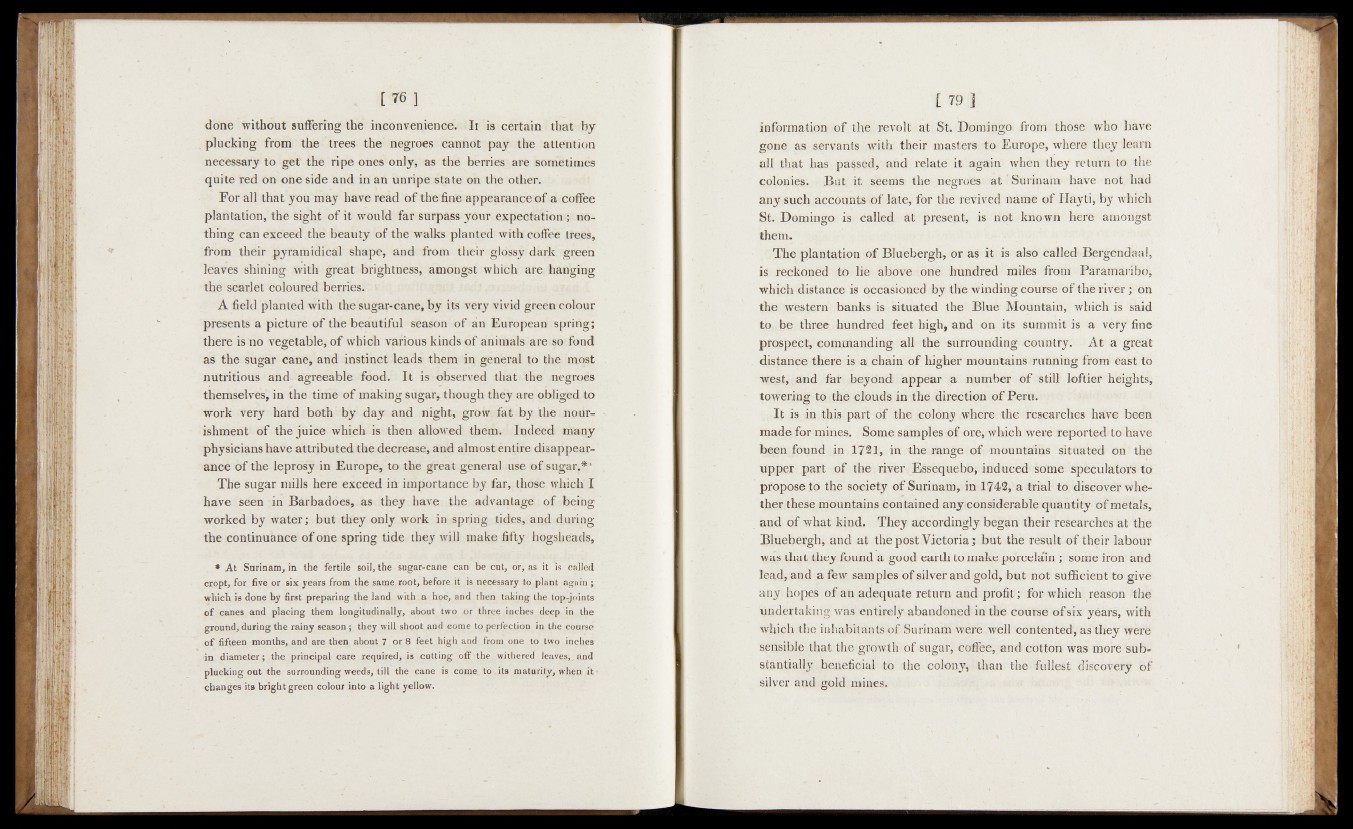
done without suffering the inconveniences It is certain that by
plucking from the trees the-negroes Cannot pay the attention
necessary to get the ripe ones only, as the berries; are sometimes
quite red on one side and in an unripe.state on the other.
For all that you may’; have read of the fine appearance of a coffee
plantation, the sight of it would far surpass yôur expectations nothing
can exceed the beauty of the walks planted with coffee trees,
from their pyramidical shape, and from their: glossy dark green
leaves shitting’ with great brightness, amongst which are hanging
the scarlet coloured berries.% v
A field planted with the sugar-cane, by its very vivid green colour
presents a picture of the beautiful season of an European spring;
there is no vegetable, of which various kinds of animals are so fond
as the sugar cane, and instinct leads: them in general to the most
nutritious and* agreeable food. It is observed that;'the negroés
themselves’, in the time of making sugar, though they>are obliged to
work very hard , both by day and. night, g row fa tb y th e nourishment
öf - the juice which is then allowed them. Indeed many
physicians have attributed the decrease, and almost entire disappearance
of the leprosy in Europe,: to the great general, use of sugar.**
Thé sugar mills here exceed in importance by farj thèâe. whieltT
have seen in Barbadóes, as they have the advantage, of being
worked by water ; but they only work in spring tides,rand,during
the continuance of otte spring tide they will make fifty hogsheads,
* At Surinam, in the fertile soil, the - sugar-cane c>h be cut, or, as it is called
cropt, for five or six years from the same root, before it is necessary to plant agaiq';
which is done by first preparing the land with-a hoe, and then taking the top-join ts
o f canes-and placing them longitudinally, about two or three inches deep in the
groundj'during the rainy season-; they will shoot, and come to perfection in the courfe
o f fifteen months, and are then about 7 ,,pr 8 feet high and. from one to two inches
in diameter; the principal care required, is cutting off the withered leaves,, and
plucking out the surrounding weeds, till the cane is come. to .its maturity, when it
changes its bright green colour into a light yellow.
information of the ^revolt at St. Domingo, from those who have
gone as servants with their masters to Europe, where' they learn
all that has parsed,'and relate i t , again when they return to the
colonies: But it seems the negroes' at Surinattr- have n#i had
any such accounts of lttte, far the ’revived name of Hay ti, by which
St. Domingo is called at presept, is not known here amongst
them.
The plantation of Bluebergh, or as it is also called« Bergendaa 1,
is reckoned to lie above: one hundred miles from Paramaribo;
which distance is occasioned by the winding course of the r iv e ro n
the western banks is situated the Blue Mountain, which is said
to be three hundred feet high, and on. its summit is a veiry fine
prospect, commanding all the surrouriding country. At a great
distance there is a; chain of higher mountains ‘running from east to
west, vand fat beyond appear a number of still loftier heights;
towering to the clouds in the direction of Peru.
It is..;in this part of the colony where the researches have been
made, for mines; Some samples of ore, y^Mch Were;reported* to have
been found in 1721, in the range of mountains situated on the
upper part of the river Essequebo, induced some speculators to
propose Jo the1 society of Surinam, in 1742, a trial to discover whether
these mountains contained any considerable quantity of metals,
and of what kind. They accordingly began their researches at the
Bluebergh, and at the post Victoria; but the result of their labour
was that they found a good earth to make porcelain; some iron and
lead, and a few samples of silver and gold, but not sufficient to give
any hopes of an adequate return and profit; for which. reasbn the
undertaking was entirely abandoned in the course of six years, with
Which the inhabitants pf-Surinam Were well contented, as they were
sensible that the .growth of -sugar;, coffee, and cotton was more substantially
beneficial to the colony, than the fullest discovery of
silver and gold; mines. it